Portal:Catholic Church
Introduction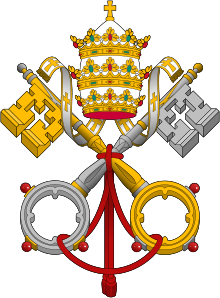 The Catholic Church, also known as the Roman Catholic Church, is the largest Christian church, with 1.28 to 1.39 billion baptized Catholics worldwide as of 2024. It is among the world's oldest and largest international institutions and has played a prominent role in the history and development of Western civilization. The church consists of 24 sui iuris churches, including the Latin Church and 23 Eastern Catholic Churches, which comprise almost 3,500 dioceses and eparchies around the world. The pope, who is the bishop of Rome, is the chief pastor of the church. The Diocese of Rome, known as the Holy See, is the central governing authority of the church. The administrative body of the Holy See, the Roman Curia, has its principal offices in Vatican City, which is a small, independent city-state and enclave within the city of Rome, of which the pope is head of state and absolute elective monarch. The core beliefs of Catholicism are found in the Nicene Creed. The Catholic Church teaches that it is the one, holy, catholic and apostolic church founded by Jesus Christ in his Great Commission, that its bishops are the successors of Christ's apostles, and that the pope is the successor to Saint Peter, upon whom primacy was conferred by Jesus Christ. It maintains that it practises the original Christian faith taught by the apostles, preserving the faith infallibly through scripture and sacred tradition as authentically interpreted through the magisterium of the church. The Roman Rite and others of the Latin Church, the Eastern Catholic liturgies, and institutes such as mendicant orders, enclosed monastic orders and third orders reflect a variety of theological and spiritual emphases in the church. Of its seven sacraments, the Eucharist is the principal one, celebrated liturgically in the Mass. The church teaches that through consecration by a priest, the sacrificial bread and wine become the body and blood of Christ. The Virgin Mary is venerated as the Perpetual Virgin, Mother of God, and Queen of Heaven; she is honoured in dogmas and devotions. Catholic social teaching emphasizes voluntary support for the sick, the poor, and the afflicted through the corporal and spiritual works of mercy. The Catholic Church operates tens of thousands of Catholic schools, universities and colleges, hospitals, and orphanages around the world, and is the largest non-government provider of education and health care in the world. Among its other social services are numerous charitable and humanitarian organizations. (Full article...) Selected article
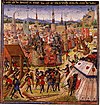 The First Crusade was launched in 1095 by Pope Urban II with the dual goals of liberating the sacred city of Jerusalem and the Holy Land from Muslims and freeing the Eastern Christians from Muslim rule. What started as an appeal by Byzantine Emperor Alexios I Komnenos for western mercenaries to fight the Seljuk Turks in Anatolia quickly turned into a wholesale Western migration and conquest of territory outside of Europe.Both knights and peasants from many nations of Western Europe travelled over land and by sea towards Jerusalem and captured the city in July 1099, establishing the Kingdom of Jerusalem and other Crusader states. Although these gains lasted for less than two hundred years, the First Crusade was a major turning point in the expansion of Western power, as well as the first major step towards reopening international trade in the West since the fall of the Western Roman Empire.
Selected image
 Credit:Click picture for information 6th century mosaic in Ravenna portrays Jesus dressed as a philosopher king in a cloak of Tyrian purple. He appears as the Pantokrator enthroned as in the Book of Revelation, with the characteristic Christian cross inscribed in the halo behind his head. Selected biography
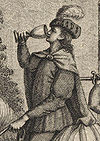 Edward the Martyr or Eadweard II (c. 962–18 March 978) was king of England from 975 until he was murdered in 978. Edward is thought to have been the son of King Edgar and Æthelflæd. His succession to the throne was contested by supporters of his half-brother Æthelred, but with Dunstan's support, Edward was acknowledged by the Witan and crowned king by Dunstan and Oswald of Worcester.Edward's reign was short and disturbed by factional strife. He was killed at Corfe Castle by servants of his stepmother the Queen Dowager Ælfthryth (Elfrida) on 18 March 978. Edward became known as "the Martyr" because of his violent end, the fact that the party opposed to him had been irreligious, and the fact that he himself had always acted as a defender of the Church. Within a short time he was regarded as a saint and his cult was established at Shaftesbury Abbey where he had been reburied circa 980. Many miracles were reported at the tomb of St Edward, including the healing of lepers and the blind.
Did you know...
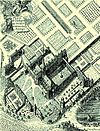
Related portalsFeast Day of January 2
Prayer: Your voice resounded throughout the world that received your word by which, in godly manner, you taught dogma, clarified the nature of beings, and set in order the character of people. Venerable father, Royal Priesthood, intercede to Christ God to grant us great mercy.
Selected quoteNews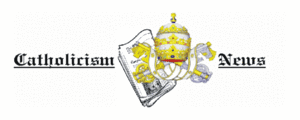
SubcategoriesTopics
The Holy Bible:
Particular Churches (grouped by liturgical rite):
Things you can do
External resourcesWikiProjectsAssociated WikimediaThe following Wikimedia Foundation sister projects provide more on this subject:
Discover Wikipedia using portals |



































